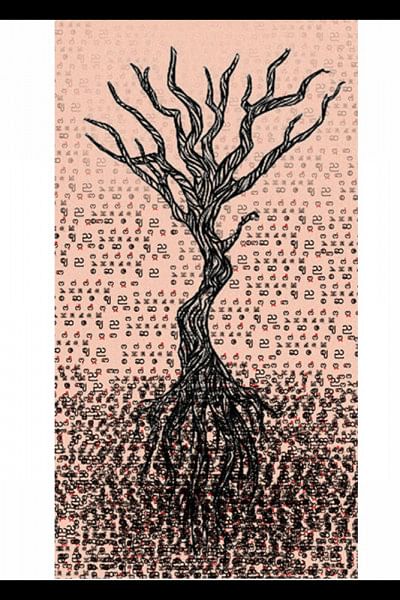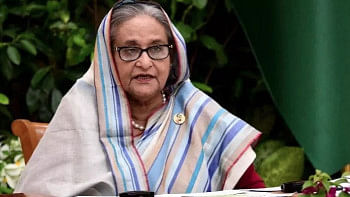Lost in documentation

A long-awaited and yet-to-be released ‘Ethno-Linguistic Survey of Bangladesh’ identifies 14 indigenous languages on the verge of extinction. Completed in 2015, this is the first large-scale linguistic survey undertaken in the country since the colonial-era ‘Linguistic Survey of India’ by George Abraham Grierson in 1928.
Sourav Sikder, primary researcher on the report and professor of linguistics at the University of Dhaka, shows me the first of the three-part series (in Bangla) which, he points out, is the shortest of the volumes to come. Though publishing of this first volume was complete in 2018, it is yet to be released to the public because the International Mother Language Institute (IMLI), which commissioned it, needs it to be inaugurated by the Prime Minister. The physical copies languish in the stores of the institute while the soft copies, similarly ready, go unpublished on the IMLI’s website—a sore point for researchers and indigenous organisations who have long been waiting for it to be published.
“I see no reason for it not to be released yet. Why should people still be looking for this information when the government has paid for this research to be completed?” asks Sikder. Starting in 2013, the two-year-long survey unfolded across the country where Sikder’s team embarked with a 40-page questionnaire, including a section where respondents were asked to tell a story in their language.
While the report remains elusive, what is out is that there are 40 languages in the country other than Bangla and that 14 ethnic languages are about to become extinct. These are Mundari, Malto, Kheying, Khumi, Kol, Chak, Pangkhwa, Pattra also called Laleng, Lusai, Khariya, Shoura, Koda, Kando and Rengmitca.
UNESCO classifies languages’ degree of endangerment thus—safe, vulnerable, definitely endangered, severely endangered, critically endangered, and extinct.
This year, the United Nations declared that, in addition to the annual celebration of August 9 as the International Day of the World’s Indigenous Peoples, 2019 would more specifically be celebrated as the International Year of Indigenous Languages.
There is division, particularly between linguists abroad and those in the country, about what constitutes separate languages. For instance, the Ethnologue website (the Bangladesh country report was done in 2013) lists more languages than the 41 in the government survey, including Rohingya, Sylheti, Rangpuri, and Chittagonian. Sikder disagrees with the latter three as do other linguistics who consider these dialects.
Disagreements such as this are not unusual in the tricky world of linguistics. Another disagreement is over Chakma and Tanchangya—while the Tanchangya community say theirs is a separate language, according to Sikder and his team’s research, it is not a separate language but a dialect of Chakma. Not excluding that as a possibility, he says such a distinction can only be definitely settled after a comparative study of the two alone. These finer points, he says, were beyond the scope of the work they did as part of the government study, due to financial and time constraints—emphasising that many researchers work for years on one language alone. Another limitation of the study, says Sikder, is that they weren’t able to delve into the oral literature or fairytales and songs that are part of the languages they were documenting.
Languages on the verge of extinction
By far, the language with the fewest number of speakers in the survey is Rengmitca, from the Sino-Tibetan language family, with 40 speakers left. The last remaining speakers of this language were recently re-discovered from within the Mro community by David Peterson, a researcher of minority languages in the Chattogram Hill Tracts (CHT). Almost all of the Rengmitca speakers are over the age of fifty, many no longer speak it in favour of the Mro language and haven’t passed it down to their children.
This language perhaps best demonstrates all the ways in which a language becomes extinct—when the number of speakers are few or declining and when these are no longer used by the next generation.
“While Mundari has around 38,000 speakers, we consider it endangered because the community no longer uses it—preferring to use Bangla, Santali or Sadri,” says Sikder. Another such language is Kurukh, spoken by the Kurukh or Oraon people, who also speak Sadri. The number of speakers, while around 30,000, is gradually declining, he says. “It is difficult language so many do not want to use, and new generation do not learn it at all—making it an endangered language.”
This is not unique to the Kurukh community. Sadri, a language developed with a mixture of Hindi, Bangla, and Urdu among others, is used by some 22 ethnic communities—a lingua franca in the tea gardens.
“The same community uses multiple languages, multiple communities use the same language,” says Sikder, giving an idea of the complexities involved in documenting these languages for the sake of preservation.
What is the International Mother Language Institute doing?
The exterior of the IMLI has characters of different languages curved into the exterior of the cylindrical structure in the front. Founded in 2011, the institute declares one of its major objectives to document and preserve mother languages, and introduce multilingual and inclusive education in the country. This is in exception of Bangla, for which there is a dedicated government-funded but autonomous institution—Bangla Academy.
Jinnat Imtiaz Ali, director-general of the IMLI, describes the methods IMLI is undertaking to preserve endangered languages, many of which have no written script. This includes collecting oral stories, recording the speakers, making a dictionary, and creating an entire corpus for each language.
This is complicated because many of the indigenous languages documented do not have a written script. “There is still no consensus on which written script is to be used for each language. It is not a matter of the government enforcing a decision—the community needs to make the decision,” says Ali.
“We are working to document endangered languages. Do you know how long it takes to document a language?” he asks rhetorically. Still, the fact remains that this is the first comprehensive linguistic survey in almost a century and is eagerly anticipated.
He emphasises that his is a research institute. “In order to fulfill these expectations, we need time. The institution is hardly eight years old. How far can we progress in this time, compared with Bangla Academy for example? They publish frequently in many fields but we do solely research which is time-consuming.”
Learning in your mother tongue
Bangla is the mainstream—used on the streets, in schools, homes and offices, and in the halls of the government. Non-Bangla speaking communities do not learn their mother tongue at school and have to learn Bangla anyway in order to use it in the workforce or for official purposes.
Until 2017, there was no formal education in the major indigenous languages. The National Education Policy of 2010 made, for the first time, an allowance for education for children in their own mother tongue was made. UNESCO recommends a minimum of six years of education for children in their mother tongue in order to sustain what they learn in their early years.
In 2013, the government began the process of publishing primary school textbooks in Chakma, Marma, Tripura, Garo, and Sadri (the indigenous languages with the highest number of speakers). While textbooks in Santali was originally also meant to be published, a conflict over which script to use within the community meant that it was scrapped. Members of the Santal community remain divided over using the Ol Chiki script or the Roman script.
Books in the five indigenous languages have been printed for grades one and two (work on the grade three textbooks is ongoing).
But as both teachers and researchers point out, those teaching the textbooks are not necessarily trained to teach the alphabets because they themselves never learned them. While they are fluent speakers, they cannot read or write in their language.
“While the learning materials are now there, teachers aren’t formally trained in order to be able to teach these,” says Sikder. Media reports, since the publication and distribution of the textbooks, have stated that in many schools, such as in the CHT, instruction at school continues in Bangla because of a lack of trained teachers.
With just the timid beginnings of providing multilingual and inclusive education across the country, and multiple indigenous languages endangered and even on the verge of extinction, it remains to be seen why the IMLI is yet to release the ethno-linguistic survey when it is sitting ready and printed. In a country where people fought for their mother tongue (albeit that of the majority) to be officially recognised, are we doing enough to preserve all the languages of Bangladesh?

 For all latest news, follow The Daily Star's Google News channel.
For all latest news, follow The Daily Star's Google News channel. 



Comments